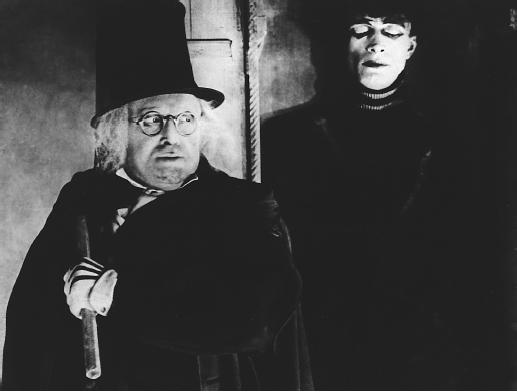Ok. So these first few reviews are going to be very laid back and informal (and simple), since I haven't done this sort of thing before. I'm going to start with something I thought I was going to hate but actually ended up enjoying.
The Cabinet of Dr. Caligari (original German title: Das Cabinet des Dr. Caligari) released in 1920 and is said to be one of the most influential German silent films of the era. As a postmark of the German Expressionistic style, it uses geometrically unusual sets and art designs to convey a sense of insanity and madness. Writers Hans Janowitz and Carl Mayer insisted on using the Expressionistic style in order to properly convey the themes of the film and to evoke what the German people were feeling during the turbulent age of post-WWI Germany.
You can see that the set is shaped in odd ways here. Sunlight is painted around the windows, and the rest of the room is a deeper, contrasting shade. Geometrically this shot is more round and flowing compared to other scenes, like this shot:
Everything is a bit more jagged here, representing the tensions that the general population was feeling and their franticness. The first screenshot shows Francis, the protagonist. Francis is presented as the sane person of this story-- the flowing geometry of his workspace seems to contribute to this depiction, as opposed to the majority of the other sets' jaggedness.
The first time we see Francis running into the asylum may be an indication of his true nature. The floor and walls are very symmetrical; not in a way that defines sanity, but madness. The architecture and design lead to the center of the room, creating an image that (to me) confuses the mind further. Throughout the whole movie we see jagged shadows and lights painted onto the set as we learn about the truth of Dr. Caligari. However, when it is revealed at the end of the film that Francis himself is the insane individual, we learn this fact in this very room. As Francis is drawn to the middle of the room by Jane, his madness is revealed. Thus the floor design and symmetry of the room all points to him.
The six act structure of the film, combined with the interesting imagery, makes it pretty darn viewable in an age where colorful lights and crazy soundtracks are needed to hold the interest of many audiences. It's also important to note that this one of the first instances in film where a framed story is used to reveal the protagonist's altered mental state at the end of the film. Since this story telling method is seen in a lot of modern films, the importance of viewing this film is made that much more significant.




No comments:
Post a Comment